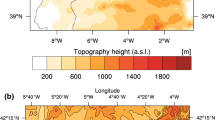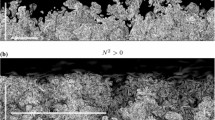Summary
An ozone mini-hole is a region of strongly depleted column total ozone amounts, associated with the growth of synoptic-scale wave disturbances. Their formation is illustrated here using a sequence of idealised model experiments. Simplified barotropic dynamics are used to drive an ozone tracer advection model on an f-plane representing a hemisphere. Firstly, the Contour Dynamics method is used to integrate the barotropic vorticity equation. Vorticity contours are initialised to simulate typical planetary wave structures and the developing wind field advects components of the ozone model. The vertical profiles of ozone mixing ratio are represented by simple linear functions, separated by a tropopause height field and capped by an upper model boundary. Integrating these profiles thus yields a total column ozone field which is closely dependent on tropopause height. In addition to horizontal advection, a vertical motion parametrisation is included, based on a quasi-geostrophic theory for tropopause displacement. The model is also used to simulate the formation of an actual mini-hole which occurred over northern Europe. Here, observed fields of vorticity, ozone and tropopause height are employed and the system integrated using a pseudo-spectral method. The mini-hole is successfully simulated, despite the simple model dynamics. The results demonstrate the correlation between column total ozone and the tropopause height and confirm the crucial role played by vertical air motions and by the meridional gradients of mid-stratospheric ozone mixing ratios for the formation of ozone mini-holes.
Similar content being viewed by others
References
Dobson, G. M. B., Harrison, D. N., Lawrence, J., 1929: Measurements of the amount of ozone in the earth's atmosphere and it's relation to other geophysical conditions: Part III.Proc. R. Soc. London,A122, 456–486.
Dütsch, H. U., 1978: Vertical ozone distribution on a global scale.Pure. Appl. Geophys.,116, 511–529.
Hoerling, M. P., Schaack, T. K., Lenzen, A. J., 1991: Global objective tropopause analysis.Mon. Wea. Rev.,119, 1816–1831.
James, P. M., 1997: A climatology of ozone mini-holes over the northern hemisphere. (in preparation).
Juckes, M. N., 1997: The mass-flux across the tropopause: Quasi-geostrophic theory.Quart. J. Roy. Meteor. Soc.,123, 71–99.
McPeters, R. D., Heath, D. F., Bhartia, P. K., 1984: Average ozone profiles for 1979 from the NIMBUS 7 SBUV instrument.J. Geophys. Res.,89, 5199–5214.
Newman, P. A., Lait, L. R., Schoeberl, M. R., 1988: The morphology and meteorology of southern hemisphere Spring total ozone mini-holes.Geophys. Res. Let.,15, 923–926.
Orszag, S. A., 1970: Transform method for the calculation of vector-coupled sums: Application to the spectral form of the vorticity equation.J. Atmos. Sci.,27, 890–895
Peters, D., Egger, J., Entzian, G., 1995: Dynamical aspects of ozone mini-hole formation.Meteorol. Atmos. Phys.,55, 205–214.
Petzold, K., Naujokat, B., Neugebohren, K., 1994: Correlation between stratospheric temperature, total ozone and tropospheric weather systems.Geophys. Res. Let.,21 No. 13, 1203–1206.
Price, J. D., Howells, A., Vaughan, G., 1994: Removal of meteorological synotpic-scale disturbances from TOMS total ozone fields.Geophys. Res. Let.,21(13), 1475–1478.
Reed, R. J., 1950: The role of vertical motions in ozone-weather relationships.J. Met.,7, 263–267.
Rood, R. B., Nielsen, J. E., Stolarski, R. S., Douglas, A. R., Kaye, J. A., Allen, D. J., 1992. Episodic total ozone minima and associated effects on heterogeneous chemistry and lower stratospheric transport.J. Geophys. Res.,97, 7979–7996.
Schoeberl, M. R., Krueger, A. J., 1983: Medium scale disturbances in total ozone during the southern hemisphere summer.Bull. Amer. Meteor. Soc.,64, 1358–1365.
Vaughan, G., Price, J., 1991: On the relation between total ozone and meteorology.Quart. J. Roy. Meteor. Soc.,117, 1281–1298.
Wirth, V., 1993: Quasi-stationary planetary waves in total ozone and their correlation with lower stratospheric temperature.J. Geophys. Res.,98, 8873–8882.
Author information
Authors and Affiliations
Additional information
With 12 Figures
Rights and permissions
About this article
Cite this article
James, P.M., Peters, D. & Greisiger, K.M. A study of ozone mini-hole formation using a tracer advection model driven by barotropic dynamics. Meteorl. Atmos. Phys. 64, 107–121 (1997). https://doi.org/10.1007/BF01044132
Received:
Revised:
Issue Date:
DOI: https://doi.org/10.1007/BF01044132




